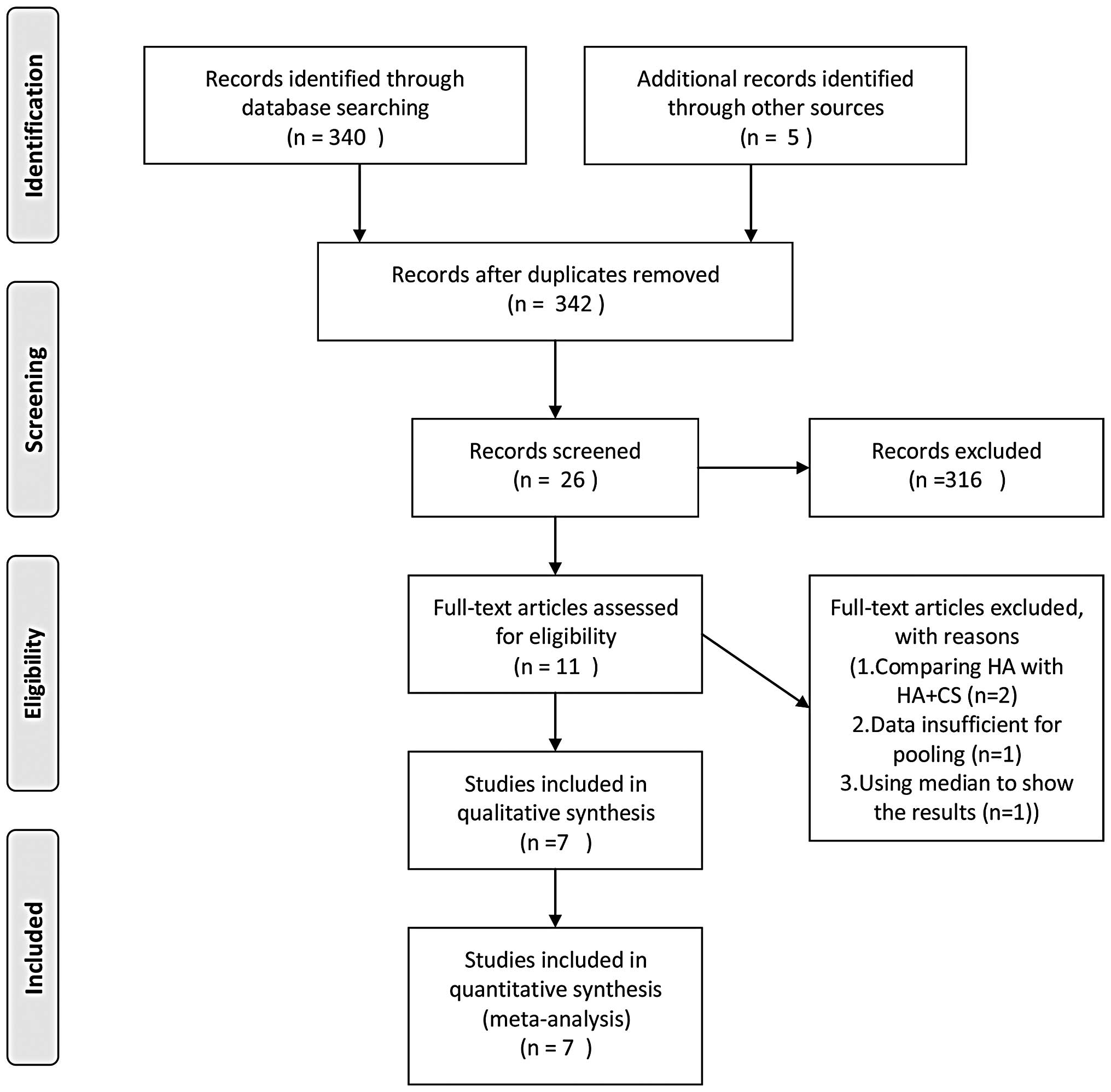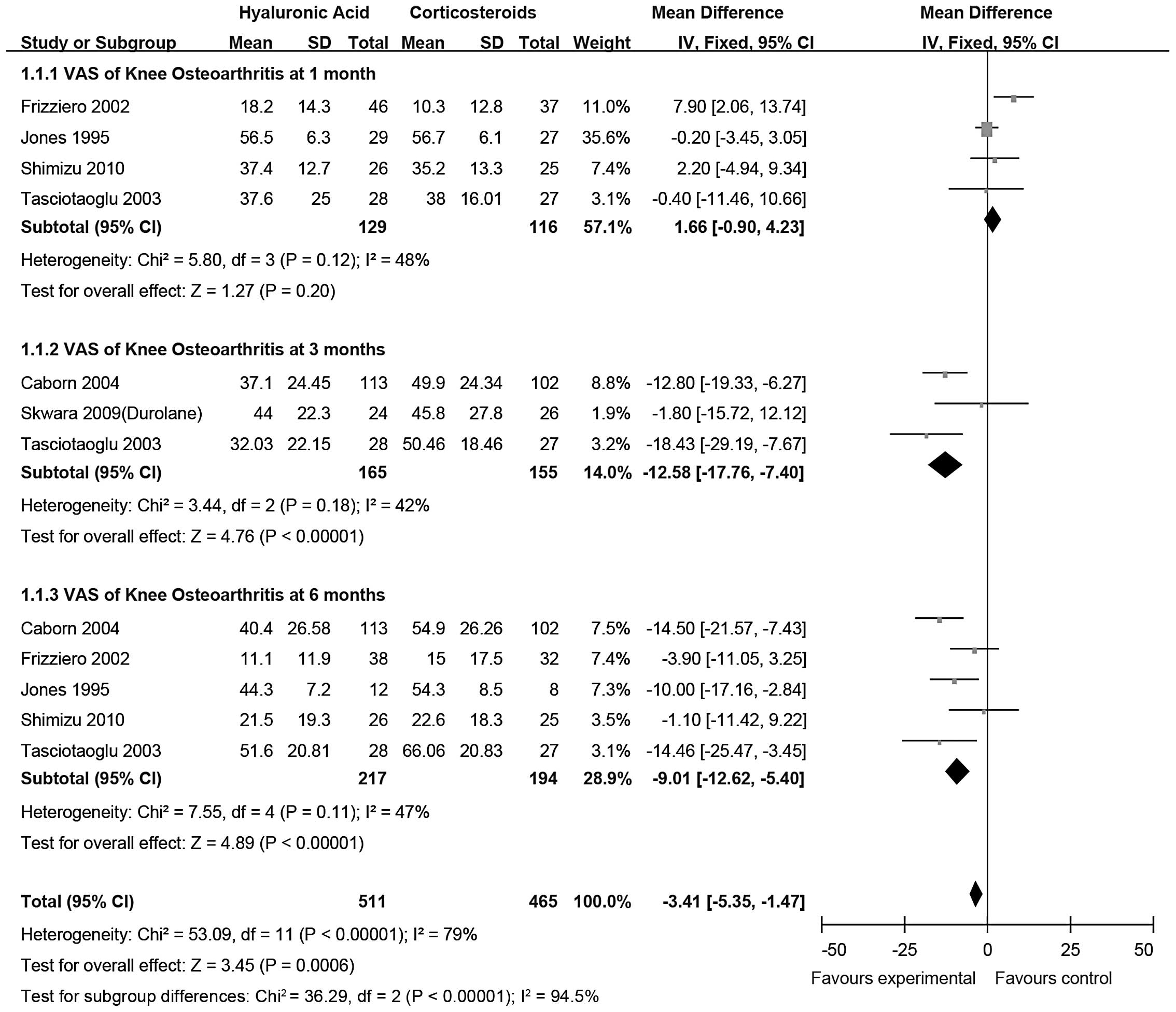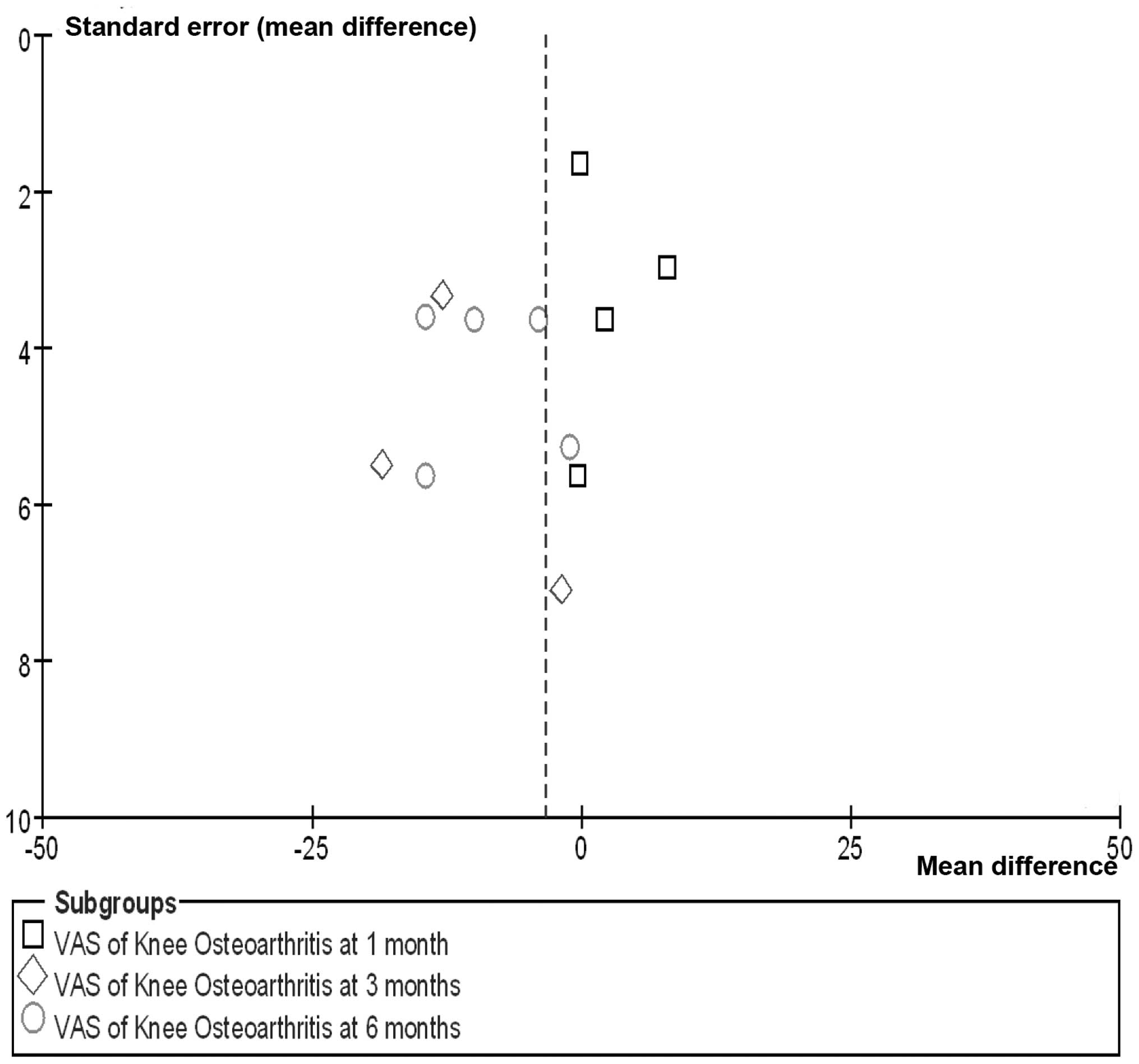|
1
|
Poole AR, Rizkalla G, Ionescu M, et al:
Osteoarthritis in the human knee: a dynamic process of cartilage
matrix degradation, synthesis and reorganization. Agents Actions
Suppl. 39:3–13. 1993.PubMed/NCBI
|
|
2
|
Ringdahl E and Pandit S: Treatment of knee
osteoarthritis. Am Fam Physician. 83:1287–1292. 2011.PubMed/NCBI
|
|
3
|
Hootman JM and Helmick CG: Projections of
US prevalence of arthritis and associated activity limitations.
Arthritis Rheum. 54:226–229. 2006. View Article : Google Scholar
|
|
4
|
Mounsey A and Ewigman B: Arthroscopic
surgery for knee osteoarthritis? Just say no. J Fam Pract.
58:143–145. 2009.PubMed/NCBI
|
|
5
|
Day R, Brooks P, Conaghan PG, et al: A
double blind, randomized, multicenter, parallel group study of the
effectiveness and tolerance of intraarticular hyaluronan in
osteoarthritis of the knee. J Rheumatol. 31:775–782.
2004.PubMed/NCBI
|
|
6
|
Shimazu A, Jikko A, Iwamoto M, et al:
Effects of hyaluronic acid on the release of proteoglycan from the
cell matrix in rabbit chondrocyte cultures in the presence and
absence of cytokines. Arthritis Rheum. 36:247–253. 1993. View Article : Google Scholar : PubMed/NCBI
|
|
7
|
Gotoh S, Onaya J, Abe M, et al: Effects of
the molecular weight of hyaluronic acid and its action mechanisms
on experimental joint pain in rats. Ann Rheum Dis. 52:817–822.
1993. View Article : Google Scholar : PubMed/NCBI
|
|
8
|
Asari A, Miyauchi S, Matsuzaka S, et al:
Molecular weight-dependent effects of hyaluronate on the arthritic
synovium. Arch Histol Cytol. 61:125–135. 1998. View Article : Google Scholar : PubMed/NCBI
|
|
9
|
Rutjes AW, Jüni P, da Costa BR, et al:
Viscosupplementation for osteoarthritis of the knee: a systematic
review and meta-analysis. Ann Intern Med. 157:180–191. 2012.
View Article : Google Scholar
|
|
10
|
Campbell J, Bellamy N and Gee T:
Differences between systemmatic reviews/meta-analyses of hyaluronic
acid/hyaluronan/hylan in osteoarthritis of the knee. Osteoarthritis
Cartilage. 15:1424–1436. 2007. View Article : Google Scholar : PubMed/NCBI
|
|
11
|
Arrich J, Piribauer F, Mad P, et al:
Intra-articular hyaluronic acid for the treatment of osteoarthritis
of the knee: systematic review and meta-analysis. CMAJ.
172:1039–1043. 2005. View Article : Google Scholar : PubMed/NCBI
|
|
12
|
Lo GH, LaValley M, McAlindon T and Felson
DT: Intra-articular hyaluronic acid in the treatment of knee
osteoarthritis: a meta-analysis. JAMA. 290:3115–3121. 2003.
View Article : Google Scholar : PubMed/NCBI
|
|
13
|
Medina JM, Thomas A and Denegar CR: Knee
osteoarthritis: should your patient opt for hyaluronic acid
injection? J Fam Pract. 55:669–675. 2006.PubMed/NCBI
|
|
14
|
Creamer P: Intra-articular corticosteroid
treatment in osteoarthritis. Curr Opin Rheumatol. 11:417–421. 1999.
View Article : Google Scholar : PubMed/NCBI
|
|
15
|
Bannuru RR, Natov NS, Obadan IE, et al:
Therapeutic trajectory of hyaluronic acid versus corticosteroids in
the treatment of knee osteoarthritis: a systematic review and
meta-analysis. Arthritis Rheum. 61:1704–1711. 2009. View Article : Google Scholar : PubMed/NCBI
|
|
16
|
Colen S, van den Bekerom MP, Mulier M and
Haverkamp D: Hyaluronic acid in the treatment of knee
osteoarthritis: a systematic review and meta-analysis with emphasis
on the efficacy of different products. BioDrugs. 26:257–268. 2012.
View Article : Google Scholar : PubMed/NCBI
|
|
17
|
Bannuru RR, Natov NS, Dasi UR, et al:
Therapeutic trajectory following intra-articular hyaluronic acid
injection in knee osteoarthritis - meta-analysis. Osteoarthritis
Cartilage. 19:611–619. 2011. View Article : Google Scholar : PubMed/NCBI
|
|
18
|
Divine JG, Zazulak BT and Hewett TE:
Viscosupplementation for knee osteoarthritis: a systematic review.
Clin Orthop Relat Res. 455:113–122. 2007. View Article : Google Scholar
|
|
19
|
Arroll B and Goodyear-Smith F:
Corticosteroid injections for osteoarthritis of the knee:
meta-analysis. BMJ. 328:8692004. View Article : Google Scholar : PubMed/NCBI
|
|
20
|
Godwin M and Dawes M: Intra-articular
steroid injections for painful knees. Systematic review with
meta-analysis. Can Fam Physician. 50:241–248. 2004.PubMed/NCBI
|
|
21
|
Jadad AR, Moore RA, Carroll D, et al:
Assessing the quality of reports on randomised clinical trials: is
blinding necessary? Control Clin Trials. 17:1–12. 1996. View Article : Google Scholar : PubMed/NCBI
|
|
22
|
Higgins JP and Thompson SG: Quantifying
heterogeneity in a meta-analysis. Stat Med. 21:1539–1558. 2002.
View Article : Google Scholar : PubMed/NCBI
|
|
23
|
Jones AC, Pattrick M, Doherty S and
Doherty M: Intra-articular hyaluronic acid compared to
intra-articular triamcinolone hexacetonide in inflammatory knee
osteoarthritis. Osteoarthritis Cartilage. 3:269–273. 1995.
View Article : Google Scholar : PubMed/NCBI
|
|
24
|
Frizziero L and Pasquali Ronchetti I:
Intra-articular treatment of osteoarthritis of the knee: an
arthroscopic and clinical comparison between sodium hyaluronate
(500–730 kDa) and methylprednisolone acetate. J Orthop Traumatol.
3:89–96. 2002. View Article : Google Scholar
|
|
25
|
Tasciotaoglu F and Oner C: Efficacy of
intra-articular sodium hyaluronate in the treatment of knee
osteoarthritis. Clin Rheumatol. 22:112–117. 2003. View Article : Google Scholar : PubMed/NCBI
|
|
26
|
Leopold SS, Redd BB, Warme WJ, et al:
Corticosteroid compared with hyaluronic acid injections for the
treatment of osteoarthritis of the knee. A prospective, randomized
trial. J Bone Joint Surg Am. 85-A:1197–1203. 2003.PubMed/NCBI
|
|
27
|
Caborn D, Rush J, Lanzer W, et al: Synvisc
901 Study Group: A randomized, single-blind comparison of the
efficacy and tolerability of hylan G-F 20 and triamcinolone
hexacetonide in patients with osteoarthritis of the knee. J
Rheumatol. 31:333–343. 2004.PubMed/NCBI
|
|
28
|
Skwara A, Ponelis R, Tibesku CO, et al:
Gait patterns after intraarticular treatment of patients with
osteoarthritis of the knee - hyaluronan versus triamcinolone: a
prospective, randomized, doubleblind, monocentric study. Eur J Med
Res. 14:157–164. 2009.PubMed/NCBI
|
|
29
|
Skwara A, Peterlein CD, Tibesku CO, et al:
Changes of gait patterns and muscle activity after intraarticular
treatment of patients with osteoarthritis of theknee: a
prospective, randomised, doubleblind study. Knee. 16:466–472. 2009.
View Article : Google Scholar : PubMed/NCBI
|
|
30
|
Shimizu M, Higuchi H, Takagishi K, et al:
Clinical and biochemical characteristics after intra-articular
injection for the treatment of osteoarthritis of the knee:
prospective randomized study of sodium hyaluronate and
corticosteroid. J Orthop Sci. 15:51–56. 2010. View Article : Google Scholar : PubMed/NCBI
|
|
31
|
Hochberg MC, Altman RD, April KT, et al:
American College of Rheumatology 2012 recommendations for the use
of nonpharmacologic and pharmacologic therapies in osteoarthritis
of the hand, hip, and knee. Arthritis Care Res (Hoboken).
64:465–474. 2012. View Article : Google Scholar
|
|
32
|
de Campos GC, Rezende MU, Pailo AF, et al:
Adding triamcinolone improves viscosupplementation: a randomized
clinical trial. Clin Orthop Relat Res. 471:613–620. PubMed/NCBI
|
|
33
|
Ozturk C, Atamaz F, Hepguler S, et al: The
safety and efficacy of intraarticular hyaluronan with/without
corticosteroid in knee osteoarthritis: 1-year, single-blind,
randomized study. Rheumatol Int. 26:314–319. 2006. View Article : Google Scholar
|
|
34
|
Tekeoglu I, Adak B, Goksoy T and Tosun N:
Effects of intra-articular injections of sodium hyaluronate
(Orthovisc) and betamethasone on osteoarthritis of the knee. J
Rheum Med Rehab. 9:220–224. 1998.
|
|
35
|
Bellamy N, Campbell J, Robinson V, et al:
Intraarticular corticosteroid for treatment of osteoarthritis of
the knee. Cochrane Database Syst Rev. CD0053282006.PubMed/NCBI
|
|
36
|
Berger VW and Alperson SY: A general
framework for the evaluation of clinical trial quality. Rev Recent
Clin Trials. 4:79–88. 2009. View Article : Google Scholar : PubMed/NCBI
|
|
37
|
Cheng J and Abdi S: Complications of
joint, tendon and muscle injections. Tech Reg Anesth Pain Manag.
11:141–147. 2007. View Article : Google Scholar
|
|
38
|
Habib GS, Saliba W and Nashashibi M: Local
effects of intra-articular corticosteroids. Clin Rheumatol.
29:347–356. 2010. View Article : Google Scholar : PubMed/NCBI
|





















